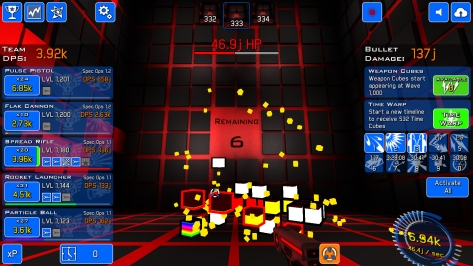
My Atari 2600 has been getting some love this week! Now that I’m done with Vanguard, I’ve returned to Phoenix, which I was playing beforehand. In fact, it’s the reason I’m playing these games at all; my recent acquisition prompted me to hook up the console and try it out. Like Vanguard, it’s a space-themed shoot ‘em up (you want me to stop there, right?) although being a fixed shooter, it has more in common with its contemporaries, such as Space Invaders and Galaxian. I enjoyed this game’s fast-pace and responsive controls, the most important factors causing my return to it.

As was the case with Vanguard, Phoenix was originally released in the arcades courtesy of Centuri. At least, in the United States; elsewhere it was published by Taito. It was introduced in 1980 and as best I can tell, was the sole output of developer Amstar Electronics. After obtaining the rights to produce a home console version, Atari outsourced development to General Computer Corporation and the final product was released in 1982. A little research reveals Michael Feinstein to be one of the port’s programmers and likely, the project lead.

The objective of Phoenix is to destroy the adversarial mothership. To reach it, players must defeat four waves of birdlike enemies. The first two waves are host to rudimentary foes that could easily be mistaken for Space Invaders fodder. The next two waves feature enemies that move faster along less predictable paths. These foes are larger and have wings that can be destroyed, but they regrow if the core of the creature isn’t shot. Finally, the penultimate stage hosts a large alien vessel that has to be whittled away until the player can eventually strike its alien pilot. With the leader destroyed, the game recycles these stages in perpetuity.
At this point, the game becomes about setting a high score. I wasn’t drawn into playing the game for so long because of this element per se, but having a competitive nature didn’t hurt! I found this to be a challenging game and I believe I’ve only been able to make it past two full sets of stages thus far. Each time I die, I feel like it was totally on me. Because the player’s spaceship moves quickly and is so responsive to input, I’m always left feeling as though I could’ve evaded the shot that killed me. This draws me in and makes me want to continue improving in an effort to get just a little farther. So even though it’s challenging, it feels like the scales are evenly tipped between the player and computer.

Phoenix is a stellar shoot ‘em up and as described is a challenging, fast-paced, responsive game that I wanted to continue playing in spite of the constant death. There’s more to it then my brief descriptions highlight, such as reaping more points for destroying closer enemies, but this tactical element didn’t factor into my sessions. That’s the sort of element that I foresee giving the game a longer tail once I move beyond just trying to see new waves and convert over to strictly score chasing. Until that point, I’m content to continue enjoying the game and my Atari 2600 as I have been.
![Phoenix [Atari 2600] – Review](https://mybrainongames.files.wordpress.com/2016/01/phoenix.jpg?w=672&h=372&crop=1)
![Vanguard [Atari 2600] – Review](https://mybrainongames.files.wordpress.com/2016/01/vanguard.jpg?w=672&h=372&crop=1)




![Time Clickers [PC/Android] – Review](https://mybrainongames.files.wordpress.com/2016/01/time-clickers.jpg?w=672&h=372&crop=1)


